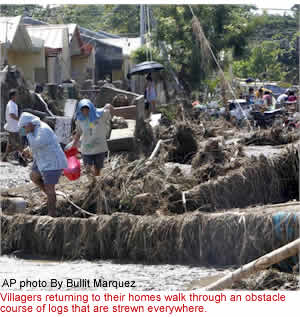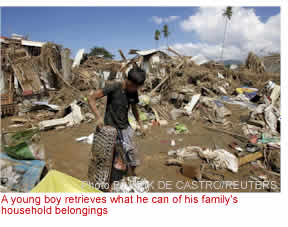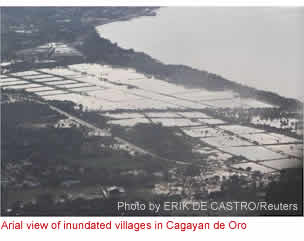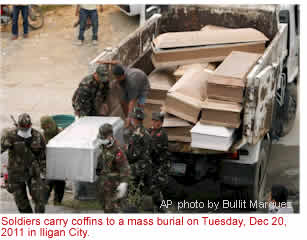BISHOPS, SOLON HOLD AQUINO, OFFICIALS ACCOUNTABLE FOR CRIMINAL NEGLECT
UN to Noy: Address root causes of tragedy
By Michaela P. del Callar12/21/2011
Lessons should be learned from such a tragedy that struck northern Mindanao and immediate steps must be taken to improve disaster mangement practices to avoid a repeat of such a massive tragedy, the United Nations said yesterday.
Catholic bishops as well as a congressman also said that government officials responsible should be held liable for such a tragedy as tropical storm “Sendong” that as of the latest count has claimed 1,000 lives and still counting.
The Philippines should learn from the recent tragedy where at least 1,000 people were feared to have been killed and the leadership should take immediate steps to improve its disaster
management practices to prevent another catastrophe of such magnitude, the UN said yesterday.
Poverty, environmental degradation, poor coordination and lack of preventive warning systems in the Philippines were identified by the UN as the major problems that resulted in enormous loss of lives and damage to communities and infrastructure when Typhoon Sendong lashed out on Cagayan de Oro, Iligan City and some parts of Visayas region over the weekend.
Margareta Wahlström, the UN Secretary General Ban Ki-Moon’s Special Representative on Disaster Risk Reduction, condoled with the typhoon victims and at the same time urged the Philippine government to immediately address the root causes of the tragedy.
“There are many lessons to be learned about risk management from this tragedy,” Wahlström said.
“First is that more must be done to ensure early warning systems are effective in an age when climate change is intensifying the impact of typhoons,” she said.
The storm was identified two days before flash floods swept through Cagayan de Oro City and Illigan City but complacent, unprepared residents ignored warnings by state weather officials as Mindanao is rarely hit by typhoons. At the same time however, local government officials insisted there was no warning issued at all. In fact, Pagasa came up with storm signal number two only for Cagayan de Oro and neighboring towns.
Wahlström said “more must be done to educate people on disasters and climate change so they understand the risk they run when they refuse to heed warnings and do not evacuate on time.”
The second, she said, is to “understand the deadly cocktail of exposure and vulnerability created by poverty, rapid urbanization and deforestation which results in huge loss of life, homes and hard-won development gains when a storm of this magnitude strikes.”
She noted that the proportion of the world’s population exposed to typhoons and cyclones has almost tripled in the last 30 years and disaster management is not keeping pace.
Philippine officials on Monday said the number of killed is threatening to breach the 1,000 death toll mark as 957 bodies have been recovered with 49 still missing.
With the devastation wrought by Sendong, UN Secretary General Ban Ki-Moon said he is “very concerned” by the impact of the storm in the Philippines.
Speaking through his spokesman, Ban expressed his sympathies to the families of those affected, to the government and the Filipino people.
Ban, along with US President Barack Obama, said the UN and Washington, respectively, stand ready to support the Philippines in responding to the disaster.
“In the spirit of our long history of friendship and cooperation with the Philippines, the United States stands ready to assist the Philippine people and government should humanitarian assistance and recovery efforts be needed,” Obama said in a statement.
Japan announced that it is providing emergency relief goods such as water tanks and generators amounting to 25 million yen or about P13 million while Australia pledged P55 million.
On top of this Australian commitment, Australia already begun distributing sleeping mats, mosquito nets, hygiene kits and cooking items are now being mobilized and distributed to displaced families in the typhoon-hit areas.
Australia will also give an additional P42 million to help the Philippine government procure essential medicines to treat the injured, provide temporary shelter for the displaced, and extend livelihood support to families who have lost their incomes.
The European Union, on the other hand, dispatched a team of humanitarian experts on the ground to identify specific needs in order to decide on appropriate response and support to be extended to the victims.
From early reports received, the major immediate needs are in the areas of food, water, clothing, blankets, lights, mosquito nets, shelter and medical assistance, the EU said.
Union officials in Manila said the forthcoming concrete support from the EU is likely to be confirmed in the coming days.
A group of Catholic Bishops slammed government officials concerned who bishops said should be held responsible for the Mindanao tragedy brought about by flashfloods from tropical typhoon Sendong which killed a thousand,with a number still missing, along with the destruction of millions worth of properties.
Cagayan de Oro Archbishop Antonio Ledesma stressed that the responsible government official found to have disregarded his responsibility that caused the deaths of a thousand caused by floods should be held liable.
Ledesma said this is a good chance for the government to remove government officials found irresponsible as he should be removed from his post.
Ledesma added that the tragedy should be investigated after continued calls for the government to provide water shed or water basin protection which up to now has never been attended to by the Aquino government.
Palawan Bishop Pedro Arigo has been firm in saying that government officials concerned involved in the illegal logging and indiscriminate mining in Mindanao which he said is the reason for the flashflood that killed hundreds of people, should be fired.
Arigo shared the same view that an investigation should be conducted and responsible officials should be made answerable to law for their negligence.
He added this tragedy doesn’t stop by merely giving relief goods to the victims. Justice must also be done for the survivors and those left behind.
Bishop Arigo challenged Aquino to seek the help in the international community for relief operations and rehabilitation for the victims of typhoon and admit that the government cannot cope with the needs of the victims.
Sorsogon Bishop Arturo Bastes said those officials should resign from their post and also called on Aquino to seek the help of the international community.
“Mining companies are responsible for cutting trees. They destroyed the environment and the country. They have the obligation to help the people there in Mindanao,” Bastes said.
The bishop also criticized Aquino for his attendance at a party of the Presidential Security Group at the height of rescue and relief operations in the areas affected
According to Bastes, what Aquino did was a shameful act and said he is sure that the Philippines would be the center of controversies in the other countries.
He even hit the slow response by the government on the victims of calamities and President Aquino favoring mining operations which is the main cause of nature destruction.
Iligan Bishop Elenito Galido blamed illegal logging and mining operation as the causer of flashflooding in Iligan City as well as various aprt of Mindanao.
Galido noted that due to indiscriminate logging there are no more trees to hold the water which caused the cascading in the lowlands that has left too many dead and missing bodies.
With deaths expected to surpass the 1,000 mark, even as thousands struggle to survive in the wake of typhoon “Sendong,” Kabataan Rep. Raymond Palatino yesterday said Aquino and his Cabinet should be held accountable for the veto of disaster preparedness in the 2011 calamity funds and for failing to install proper preventive measures to mitigate natural disasters.
“As early as Oct. 5 this year, during the budget talks in the House of Representatives, we had already raised concerns on the President’s veto of disaster preparedness in the P5 billion calamity fund and its impact on government capacity to mitigate calamities. In the aftermath of Sendong, it again becomes clear that the government still has no proper disaster preparation framework in place,” Palatino said.
“Typhoons are inevitable but the damage they may cause are preventable. Government officials are right in saying that massive destruction in Northern Mindanao was not simply caused by the heavy rains; they are mistaken, however, to downplay the crucial role of disaster preparedness in alleviating the shattering impact of the deadly typhoon,” Palatino added.
Responding to Palace spokesman Edwin Lacierda who yesterday said Palatino should “not politicize the issue”, the youth solon retorted that the Executive is just evading the issue on the lack of a rational disaster preparation program “with its standard arrogance against valid criticisms.”
“More than the relief goods and the perfunctory visits of the First Family to affected areas, what our Mindanaons ultimately need is justice for the criminal neglect of the government,” said Palatino. “The issue of disasters is inherently political in this regard as it involves government policies and accountability.”
Palatino also chastised Aquino for being so insensitive to the plight of Sendong’s victims as he was caught partying with starlets when the rsidents of Cagayan de Oro and Iligan were busy looking for their missing relatives.
“That President Aquino was caught partying in the wake of Sendong is a form of insensitivity that exposes only the tip of the mud pile, as it were. The more serious kind of insensitivity the President is complicit to is the systemic disregard to the welfare of the poor who, in the absence of a rational disaster plan, are the most vulnerable during calamities,” Palatino added. With Pat C. Santos and Charlie V. Manalo property destroyed is totally unacceptable to this struggling nation of close to a hundred million people. The Aquino government must to get to the bottom of this. Already, the finger-pointing has begun. PAGASA (Philippine Atmospheric, Geophysical and Astronomical Services Administration) claims their storm-warning bulletins were disregarded by local officials. Local officials on the other hand complain that they were never told how devastating typhoon Sendong (Washi) really was.
property destroyed is totally unacceptable to this struggling nation of close to a hundred million people. The Aquino government must to get to the bottom of this. Already, the finger-pointing has begun. PAGASA (Philippine Atmospheric, Geophysical and Astronomical Services Administration) claims their storm-warning bulletins were disregarded by local officials. Local officials on the other hand complain that they were never told how devastating typhoon Sendong (Washi) really was. government officials whose job it is to inform the public of approaching weather systems and the potential havoc they bring.
government officials whose job it is to inform the public of approaching weather systems and the potential havoc they bring. Louisiana’s flood-prone parishes, they reassessed their flood protection system as well, and now have new procedures in place to prevent a repeat of their inadequate response to Katrina.
Louisiana’s flood-prone parishes, they reassessed their flood protection system as well, and now have new procedures in place to prevent a repeat of their inadequate response to Katrina. Illegal logging appears to have magnified the devastation wrought by Sendong. Denuded forests and timber-clogged waterways amplified the catastrophe in the cities of Iligan and Cagayan de Oro.
Illegal logging appears to have magnified the devastation wrought by Sendong. Denuded forests and timber-clogged waterways amplified the catastrophe in the cities of Iligan and Cagayan de Oro.